The groves of academe have been buzzing with debate about Zaha HadidŌĆÖs Softbridge project, now on site at St AnthonyŌĆÖs college, Oxford. But for BamŌĆÖs engineering team constructing its cylindrical form in a desperately constrained site was an education in itself
The colleges and quadrangles of Oxford may not seem the obvious choice for Zaha HadidŌĆÖs avowedly futuristic brand of architecture but that is exactly what is being built in one of the institutionŌĆÖs youngest colleges.
St AnthonyŌĆÖs College was founded in 1950 and now forms the backdrop to the emerging form of the Softbridge project currently under construction by Bam.
The ┬Ż11m project is an extension to the collegeŌĆÖs Middle East Centre and will link two of its existing buildings. In contrast to the Victorian and mock-Tudor buildings that frame it, Softbridge will be a smooth, sinuous metallic tube with a curved profile and sloping roof. The building will provide a new entrance and reception to the Middle East Centre and offer a library, reading room, archive and 125-seat basement auditorium.
At three storeys high and with only 1,200m┬▓ of accommodation Softbridge is relatively small. But, as with many Hadid buildings, it set a number of exacting engineering challenges that have defined its construction. These include its funneling cylindrical form which means that almost every surface in the building curves in two or three dimensions.
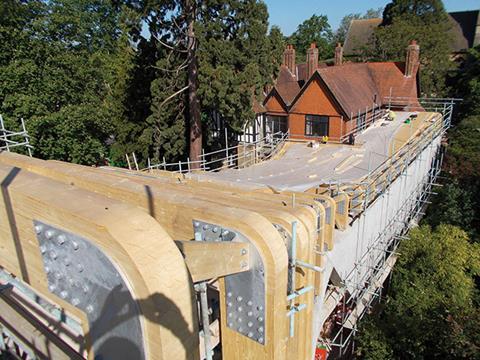
Further complexity is caused by the new buildingŌĆÖs extraordinarily constrained site. Not only is it hemmed in by historic buildings on either side but it suffers from severely limited access and endured the unusual circumstance of essentially having to be built around a protected, historic Californian Redwood sequoia tree, one of a pair located in and beside the site. Even scaffolding has had to be cantilevered over the roots area in order to prevent damage.
The Softbridge building comprises a cast in-situ concrete frame structure with a 7m deep basement. Its distinctive, curving, funnel-like envelope is formed by a ribcage of 34 curved glulam beams rising above the first floor slab. The glulam beams are clad in a continuous, paneled stainless steel rainscreen that wraps over both external walls and roof.
The steel funnel is a primarily windowless structure with the exception of circular ŌĆ£teardropŌĆØ skylights cut into the roof. Underneath the funnel the ground floor is glazed to give the appearance of a floating tubular object above. This effect is achieved by the first floor slab being cantilevered over the ground floor and partially supported by a large, prominent concrete V-column, which, to accommodate the curvature of the structural frame, also curves improbably in two directions. This feature is strongly reminiscent of the much larger double-curving V-columns employed on another celebrated Zaha Hadid project, the London 2012 aquatics centre.
At present, both the concrete and glulam structural frames have been constructed as well as the roof and basement. The steel cladding panels are due to be installed shortly. ║├╔½Ž╚╔·TV handover is scheduled for November this year.
One of the earliest and most challenging aspects of the project involved construction around the protected Redwood tree. As Bam senior site manager Martin Sandall explains, this necessitated an extremely complicated and intricate process to protect both the tree and its roots at all times.
ŌĆ£We had to dig around the tree by hand using air spades to stop the roots being damaged. This is a process by which a jet of air blasts the topsoil away rather than it being manually dug in order to protect the roots. To provide an extra layer of protection during construction, the roots were then wrapped in large diameter plastic sleeves filled with sand and hessian.ŌĆØ
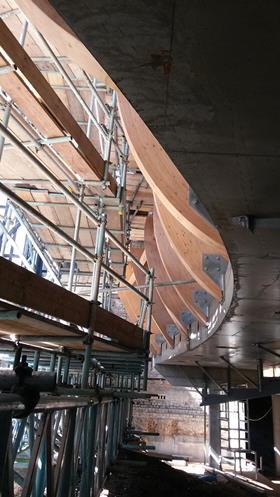
As Bam construction director Anthony Nagle explains, further onerous protection measures were also necessary once piling began.
ŌĆ£We used CFA (continuous flight augering) piling but it was of paramount importance that the piling process did not contaminate the ground around the roots and potentially the roots themselves. So we installed a drainage sleeve around the piles which acted like an irrigation system that prevented chemicals seeping back into the ground. The final roots protection measure was the 200mm temporary concrete slab constructed over the roots throughout construction.ŌĆØ
With two historic buildings on either side of the construction area, both of which abut directly against the Softbridge structure, piling also had to be handled with great care and sensitivity. On two sides of the basement conventional sheet u-piling is used. But on the remaining two sides adjacent to the existing historic buildings, a special piling solution known as ŌĆ£zeroŌĆØ piling is employed.
Zero piling is a process that involves a piling machine pushing piles into the ground one after the other using the shaft friction of the previously
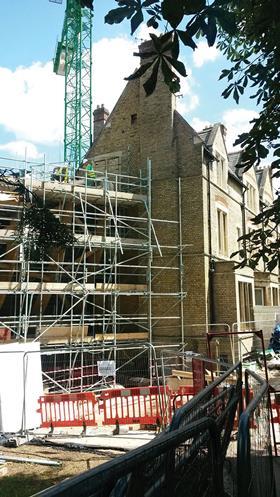
installed pile to provide a reaction force required to press in the next one. The method virtually eliminates vibration from the piling process which makes it particularly suited to tight or restricted areas or, as at Softbridge, instances when piling directly against existing buildings or foundations is required.
The process earns its name by offering ŌĆ£zeroŌĆØ clearance to adjacent structures - at Softbridge it enabled piles to be installed within just 100mm of the existing buildings on either side. According to Nagle, it was the ŌĆ£best possible system for the extremely constrained conditions on the siteŌĆØ.
Aesthetically, the glulam ribcage is one of the most prominent parts of the building, even though the glulam will be entirely covered in GRG panels internally once the building is complete. As Nagle explains, the structureŌĆÖs complicated form made the glulam the natural material to express the buildingŌĆÖs funnel-like form. ŌĆ£We did consider steel but due to the complexity of the shape and the multiple curving nature of many of its elements, glulam emerged as the better solution.ŌĆØ
The steel panels, which will be clad over the glulam, will vary in size from around 1.5m wide to 4m tall and will be laid over a layer of insulation and waterproof membrane. The large size of the panels combined with their high levels of reflectivity is designed to create the illusion of an un-jointed, continuous skin.
While GRG will clad the glulam internally, exposed concrete will be very much on display in the building interiors. All concrete is fair faced and self-compacting, details which Nagle reveals were generated by exacting architectural requirements. ŌĆ£The architects knew exactly what they wanted and the quality of the concrete finish was a key aesthetic issue. To guarantee the best finish possible and to achieve a shine effect, the concrete is self-compacting and formed within a plastic resin board.ŌĆØ
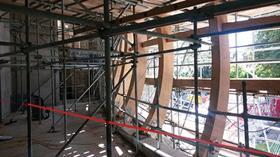
Another significant feature of both the interior and exterior is the entrance. This is located at the rear of the building and features a triple-height glass curtain wall. Despite its height, the glazing is unsupported and fixed to its surrounding structure by stainless steel angles. It also features extraordinarily slender transom mullions just 30mm wide.
For Nagle, it would have been almost impossible to design a building of this geometric complexity without the 3D model that was developed at design stage and has been subsequently developed and used by all members of the design team. ŌĆ£It simply wasnŌĆÖt possible to build this kind of building using conventional structural drawings. The model was initially developed by the architects and further levels of information were added by all the various subcontractors, specialists and consultants working on the project.ŌĆØ
Unsurprisingly, Nagle also identifies the tightly constrained site as one of the projectŌĆÖs biggest challenges. ŌĆ£Everything to do with access to and movement within the site was a challenge. We tried to make as many components as possible small enough to be manhandled, and due to site and loading restrictions, larger elements had to be lifted and lowered into place by an external tower crane.ŌĆØ
However, perhaps surprisingly, Nagle is both sanguine and enthusiastic about working on such a complex and unconventional structural form and collaborating with architects who required such an exacting level of technical precision. ŌĆ£ItŌĆÖs actually a treat to work on one-off projects like this. Yes, the specifications are exacting but I personally get great levels of satisfaction, exhilaration and enjoyment from making structures like this work.ŌĆØ
Project team
Client St AnthonyŌĆÖs College
Architect Zaha Hadid Architects
Contractor Bam
Structural engineer AKT II
M&E engineer Max Fordham
Landscape architects Gross Max





















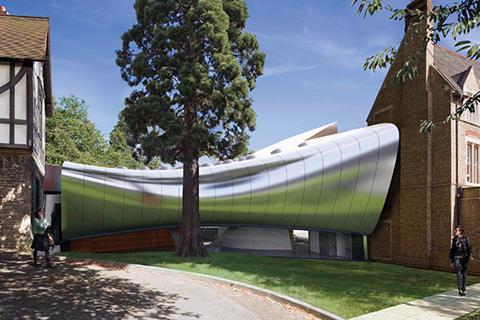
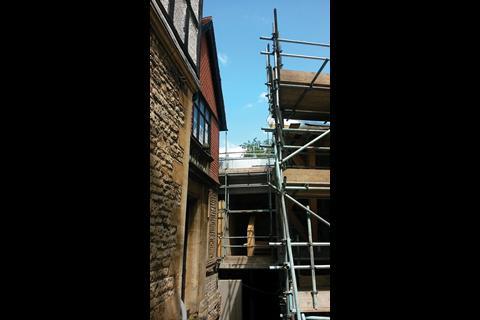










1 Readers' comment